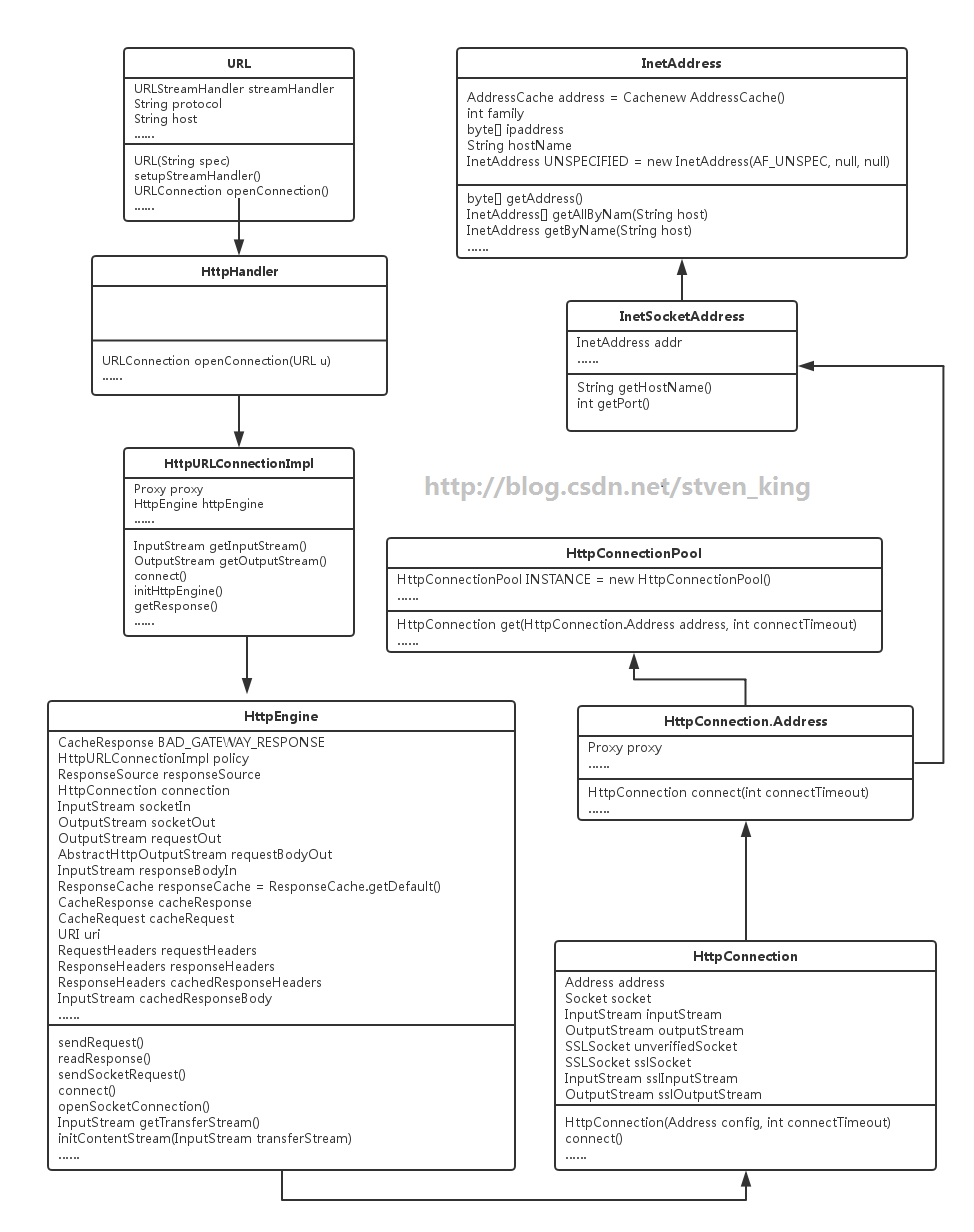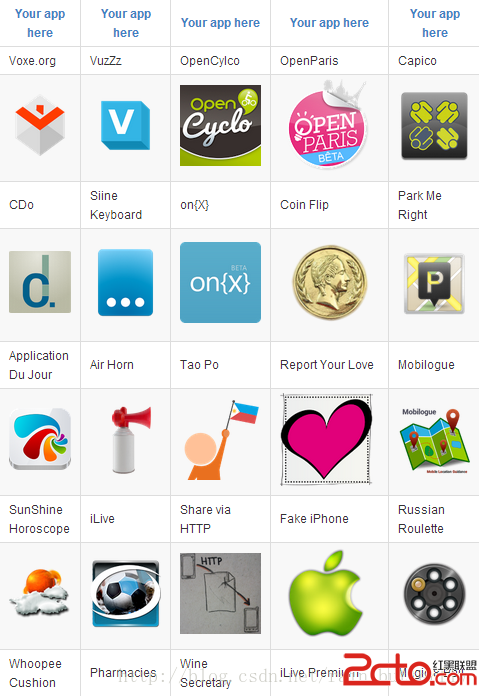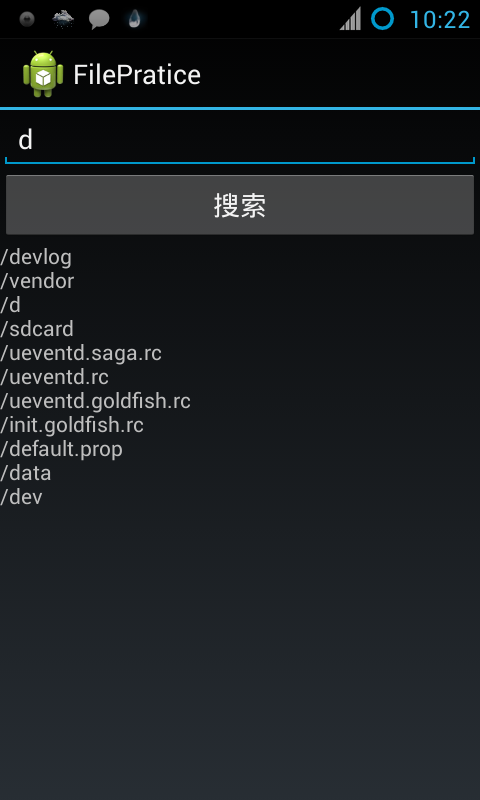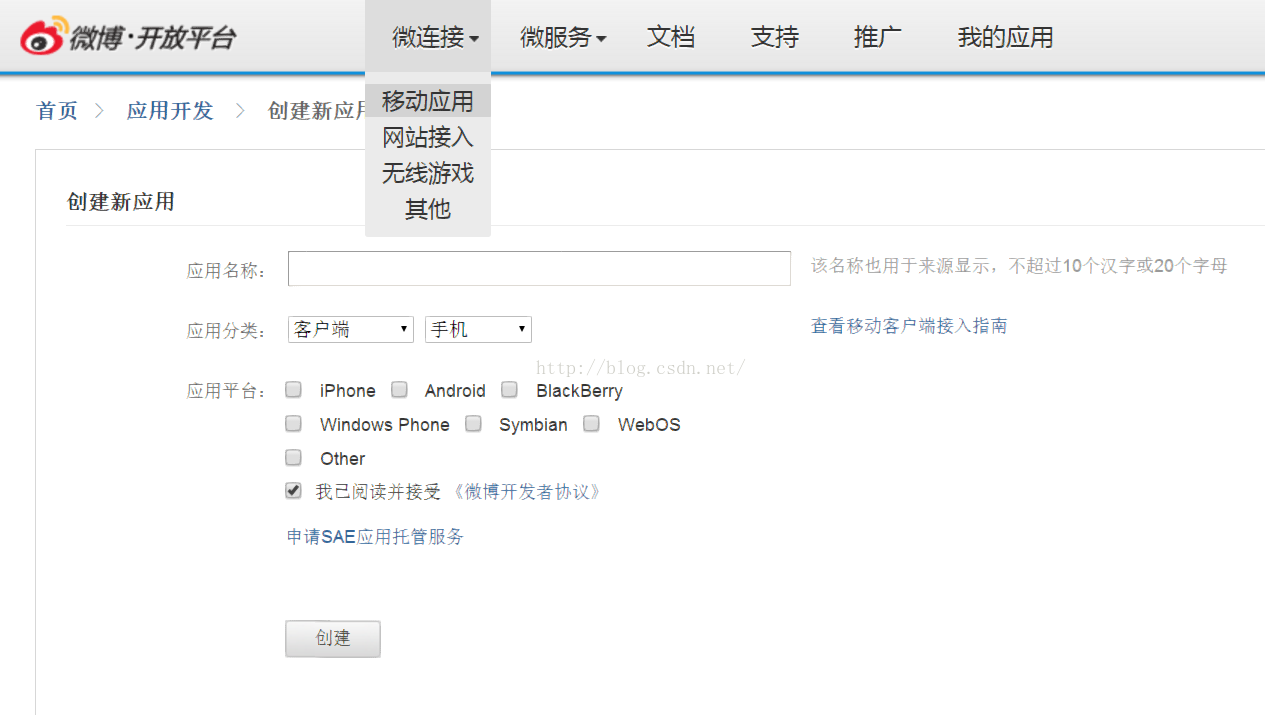編輯:關於Android編程
多年以前Android的網絡請求只有Apache開源的HttpClient和JDK的HttpUrlConnection,近幾年隨著OkHttp的流行Android在高版本的SDK中加入了OkHttp。但在Android官方文檔中推薦使用HttpUrlConnection並且其會一直被維護,所以在學習Android網絡相關的知識時我們隊HttpUrlConnection要有足夠的了解。。。。
前幾天因為時間的關系只畫了圖 HttpUrlConnection和Socket的關系圖 ,本來說好的第二天續寫,結果一直拖到了周末晚上。幸好時間還來的及,趁這短時間影響深刻,將自己解析代碼過程記錄下來。(PS:解析的過程有什麼地方不明白的可以看看 HttpUrlConnection和Socket的關系圖 圖中講出的過程和這次代碼分析的過程是一樣的,只不過代碼講述更加詳細。所有源碼都是來自Android4.0.4。有代碼就有真相~!~!)
先給大家展示一張相關類的結構圖:

在分析代碼的時候我希望首相腦海中要有一個URL的請求過程。
這是我在網上摘的一個HttpUrlConnection請求小Demo:
public class EsmTest {
/**
* 通過HttpURLConnection模擬post表單提交
* @throws Exception
*/
@Test
public void sendEms() throws Exception {
String wen = "MS2201828";
String btnSearch = "EMS快遞查詢";
URL url = new URL("http://www.kd185.com/ems.php");
HttpURLConnection conn = (HttpURLConnection) url.openConnection();
conn.setRequestMethod("POST");// 提交模式
// conn.setConnectTimeout(10000);//連接超時 單位毫秒
// conn.setReadTimeout(2000);//讀取超時 單位毫秒
conn.setDoOutput(true);// 是否輸入參數
StringBuffer params = new StringBuffer();
// 表單參數與get形式一樣
params.append("wen").append("=").append(wen).append("&")
.append("btnSearch").append("=").append(btnSearch);
byte[] bypes = params.toString().getBytes();
conn.getOutputStream().write(bypes);// 輸入參數
InputStream inStream=conn.getInputStream();
System.out.println(new String(StreamTool.readInputStream(inStream), "gbk"));
}
public void sendSms() throws Exception{
String message="貨已發到";
message=URLEncoder.encode(message, "UTF-8");
System.out.println(message);
String path ="http://localhost:8083/DS_Trade/mobile/sim!add.do?message="+message;
URL url =new URL(path);
HttpURLConnection conn = (HttpURLConnection)url.openConnection();
conn.setConnectTimeout(5*1000);
conn.setRequestMethod("GET");
InputStream inStream = conn.getInputStream();
byte[] data = StreamTool.readInputStream(inStream);
String result=new String(data, "UTF-8");
System.out.println(result);
}
}
/*****************URL.java************************/
/**
* 創建一個新的URL實例
*/
public URL(String spec) throws MalformedURLException {
this((URL) null, spec, null);
}
public URL(URL context, String spec, URLStreamHandler handler) throws MalformedURLException {
if (spec == null) {
throw new MalformedURLException();
}
if (handler != null) {
streamHandler = handler;
}
spec = spec.trim();
//獲取url的協議類型,http,https
protocol = UrlUtils.getSchemePrefix(spec);
//請求開始部分的位置
int schemeSpecificPartStart = protocol != null ? (protocol.length() + 1) : 0;
if (protocol != null && context != null && !protocol.equals(context.protocol)) {
context = null;
}
if (context != null) {
set(context.protocol, context.getHost(), context.getPort(), context.getAuthority(),
context.getUserInfo(), context.getPath(), context.getQuery(),
context.getRef());
if (streamHandler == null) {
streamHandler = context.streamHandler;
}
} else if (protocol == null) {
throw new MalformedURLException("Protocol not found: " + spec);
}
//這裡為重點,獲取StreamHandler
if (streamHandler == null) {
setupStreamHandler();
if (streamHandler == null) {
throw new MalformedURLException("Unknown protocol: " + protocol);
}
}
try {
//對url的處理
streamHandler.parseURL(this, spec, schemeSpecificPartStart, spec.length());
} catch (Exception e) {
throw new MalformedURLException(e.toString());
}
}
void setupStreamHandler() {
//從緩存中獲取
streamHandler = streamHandlers.get(protocol);
if (streamHandler != null) {
return;
}
//通過工廠方法創建
if (streamHandlerFactory != null) {
streamHandler = streamHandlerFactory.createURLStreamHandler(protocol);
if (streamHandler != null) {
streamHandlers.put(protocol, streamHandler);
return;
}
}
//在同名包下檢測一個可用的hadnler
String packageList = System.getProperty("java.protocol.handler.pkgs");
ClassLoader contextClassLoader = Thread.currentThread().getContextClassLoader();
if (packageList != null && contextClassLoader != null) {
for (String packageName : packageList.split("\\|")) {
String className = packageName + "." + protocol + ".Handler";
try {
Class c = contextClassLoader.loadClass(className);
streamHandler = (URLStreamHandler) c.newInstance();
if (streamHandler != null) {
streamHandlers.put(protocol, streamHandler);
}
return;
} catch (IllegalAccessException ignored) {
} catch (InstantiationException ignored) {
} catch (ClassNotFoundException ignored) {
}
}
}
//如果還是沒有創建成功那麼new一個handler
if (protocol.equals("file")) {
streamHandler = new FileHandler();
} else if (protocol.equals("ftp")) {
streamHandler = new FtpHandler();
} else if (protocol.equals("http")) {
streamHandler = new HttpHandler();
} else if (protocol.equals("https")) {
streamHandler = new HttpsHandler();
} else if (protocol.equals("jar")) {
streamHandler = new JarHandler();
}
if (streamHandler != null) {
streamHandlers.put(protocol, streamHandler);
}
}
/**
* streamHandler實現類為HttpURLConnectionImpl
*/
public final class HttpHandler extends URLStreamHandler {
@Override protected URLConnection openConnection(URL u) throws IOException {
return new HttpURLConnectionImpl(u, getDefaultPort());
}
@Override protected URLConnection openConnection(URL url, Proxy proxy) throws IOException {
if (url == null || proxy == null) {
throw new IllegalArgumentException("url == null || proxy == null");
}
return new HttpURLConnectionImpl(url, getDefaultPort(), proxy);
}
@Override protected int getDefaultPort() {
return 80;
}
}
/*****************HttpURLConnectionImpl.java start************************/
/**
* 無論是get還是post都需要建立連接
* post
*/
@Override
public final OutputStream getOutputStream() throws IOException {
connect();
OutputStream result = httpEngine.getRequestBody();
if (result == null) {
throw new ProtocolException("method does not support a request body: " + method);
} else if (httpEngine.hasResponse()) {
throw new ProtocolException("cannot write request body after response has been read");
}
return result;
}
/**
* 無論是get還是post都需要建立連接
* get
*/
@Override
public final InputStream getInputStream() throws IOException {
if (!doInput) {
throw new ProtocolException("This protocol does not support input");
}
//獲取http響應
HttpEngine response = getResponse();
//返回400拋異常
if (getResponseCode() >= HTTP_BAD_REQUEST) {
throw new FileNotFoundException(url.toString());
}
InputStream result = response.getResponseBody();
if (result == null) {
throw new IOException("No response body exists; responseCode=" + getResponseCode());
}
return result;
}
private HttpEngine getResponse() throws IOException {
//初始化http引擎
initHttpEngine();
//是否有響應頭信息
if (httpEngine.hasResponse()) {
return httpEngine;
}
try {
while (true) {
//發送請求
httpEngine.sendRequest();
httpEngine.readResponse();
//為下次請求做准備
Retry retry = processResponseHeaders();
if (retry == Retry.NONE) {
httpEngine.automaticallyReleaseConnectionToPool();
break;
}
//如果一個請求不能完成那麼接下來為下次請求做准備
String retryMethod = method;
OutputStream requestBody = httpEngine.getRequestBody();
/*
* Although RFC 2616 10.3.2 specifies that a HTTP_MOVED_PERM
* redirect should keep the same method, Chrome, Firefox and the
* RI all issue GETs when following any redirect.
*/
int responseCode = getResponseCode();
if (responseCode == HTTP_MULT_CHOICE || responseCode == HTTP_MOVED_PERM
|| responseCode == HTTP_MOVED_TEMP || responseCode == HTTP_SEE_OTHER) {
retryMethod = HttpEngine.GET;
requestBody = null;
}
if (requestBody != null && !(requestBody instanceof RetryableOutputStream)) {
throw new HttpRetryException("Cannot retry streamed HTTP body",
httpEngine.getResponseCode());
}
if (retry == Retry.DIFFERENT_CONNECTION) {
httpEngine.automaticallyReleaseConnectionToPool();
}
httpEngine.release(true);
httpEngine = newHttpEngine(retryMethod, rawRequestHeaders,
httpEngine.getConnection(), (RetryableOutputStream) requestBody);
}
return httpEngine;
} catch (IOException e) {
httpEngineFailure = e;
throw e;
}
}
@Override
public final void connect() throws IOException {
initHttpEngine();
try {
httpEngine.sendRequest();
} catch (IOException e) {
httpEngineFailure = e;
throw e;
}
}
/**
* 無論是get還是post都需要初始化Http引擎
*/
private void initHttpEngine() throws IOException {
if (httpEngineFailure != null) {
throw httpEngineFailure;
} else if (httpEngine != null) {
return;
}
connected = true;
try {
if (doOutput) {
if (method == HttpEngine.GET) {
//如果要寫入那麼這就是一個post請求
method = HttpEngine.POST;
} else if (method != HttpEngine.POST && method != HttpEngine.PUT) {
//如果你要寫入,那麼不是post請求也不是put請求那就拋異常吧。
throw new ProtocolException(method + " does not support writing");
}
}
httpEngine = newHttpEngine(method, rawRequestHeaders, null, null);
} catch (IOException e) {
httpEngineFailure = e;
throw e;
}
}
/********************HttpEngine.java**************/
/**
* Figures out what the response source will be, and opens a socket to that
* source if necessary. Prepares the request headers and gets ready to start
* writing the request body if it exists.
*/
public final void sendRequest() throws IOException {
if (responseSource != null) {
return;
}
//填充請求頭和cookies
prepareRawRequestHeaders();
//初始化響應資源,計算緩存過期時間,判斷是否讀取緩沖中數據,或者進行網絡請求
//responseSource = ?
//CACHE:返回緩存信息
//CONDITIONAL_CACHE:進行網絡請求如果網絡請求結果無效則使用緩存
//NETWORK:返回網絡請求
initResponseSource();
//請求行為記錄
if (responseCache instanceof HttpResponseCache) {
((HttpResponseCache) responseCache).trackResponse(responseSource);
}
//請求資源需要訪問網絡,但請求頭部禁止請求。在這種情況下使用BAD_GATEWAY_RESPONSE替代
if (requestHeaders.isOnlyIfCached() && responseSource.requiresConnection()) {
if (responseSource == ResponseSource.CONDITIONAL_CACHE) {
IoUtils.closeQuietly(cachedResponseBody);
}
this.responseSource = ResponseSource.CACHE;
this.cacheResponse = BAD_GATEWAY_RESPONSE;
RawHeaders rawResponseHeaders = RawHeaders.fromMultimap(cacheResponse.getHeaders());
setResponse(new ResponseHeaders(uri, rawResponseHeaders), cacheResponse.getBody());
}
if (responseSource.requiresConnection()) {
//socket網絡連接
sendSocketRequest();
} else if (connection != null) {
HttpConnectionPool.INSTANCE.recycle(connection);
connection = null;
}
}
private void sendSocketRequest() throws IOException {
if (connection == null) {
connect();
}
if (socketOut != null || requestOut != null || socketIn != null) {
throw new IllegalStateException();
}
socketOut = connection.getOutputStream();
requestOut = socketOut;
socketIn = connection.getInputStream();
if (hasRequestBody()) {
initRequestBodyOut();
}
}
//打開Socket連接
protected void connect() throws IOException {
if (connection == null) {
connection = openSocketConnection();
}
}
protected final HttpConnection openSocketConnection() throws IOException {
HttpConnection result = HttpConnection.connect(
uri, policy.getProxy(), requiresTunnel(), policy.getConnectTimeout());
Proxy proxy = result.getAddress().getProxy();
if (proxy != null) {
policy.setProxy(proxy);
}
result.setSoTimeout(policy.getReadTimeout());
return result;
}
/********************HttpConnection.java**************/
public static HttpConnection connect(URI uri, Proxy proxy, boolean requiresTunnel,
int connectTimeout) throws IOException {
//代理直連
if (proxy != null) {
Address address = (proxy.type() == Proxy.Type.DIRECT)
? new Address(uri)
: new Address(uri, proxy, requiresTunnel);
return HttpConnectionPool.INSTANCE.get(address, connectTimeout);
}
//尋找代理直連
ProxySelector selector = ProxySelector.getDefault();
List proxyList = selector.select(uri);
if (proxyList != null) {
for (Proxy selectedProxy : proxyList) {
if (selectedProxy.type() == Proxy.Type.DIRECT) {
// the same as NO_PROXY
// TODO: if the selector recommends a direct connection, attempt that?
continue;
}
try {
Address address = new Address(uri, selectedProxy, requiresTunnel);
return HttpConnectionPool.INSTANCE.get(address, connectTimeout);
} catch (IOException e) {
// failed to connect, tell it to the selector
selector.connectFailed(uri, selectedProxy.address(), e);
}
}
}
//創建一個直連接
return HttpConnectionPool.INSTANCE.get(new Address(uri), connectTimeout);
}
private HttpConnection(Address config, int connectTimeout) throws IOException {
this.address = config;
Socket socketCandidate = null;
InetAddress[] addresses = InetAddress.getAllByName(config.socketHost);
for (int i = 0; i < addresses.length; i++) {
socketCandidate = (config.proxy != null && config.proxy.type() != Proxy.Type.HTTP)
? new Socket(config.proxy)
: new Socket();
try {
//DNS解析,socket連接(這塊不做詳細分析)
socketCandidate.connect(
new InetSocketAddress(addresses[i], config.socketPort), connectTimeout);
break;
} catch (IOException e) {
if (i == addresses.length - 1) {
throw e;
}
}
}
this.socket = socketCandidate;
}
/********************HttpConnectionPool.java**************/
public HttpConnection get(HttpConnection.Address address, int connectTimeout)
throws IOException {
//首先嘗試重用現有的HTTP連接。
synchronized (connectionPool) {
List connections = connectionPool.get(address);
if (connections != null) {
while (!connections.isEmpty()) {
HttpConnection connection = connections.remove(connections.size() - 1);
if (!connection.isStale()) { // TODO: this op does I/O!
// Since Socket is recycled, re-tag before using
final Socket socket = connection.getSocket();
SocketTagger.get().tag(socket);
return connection;
}
}
connectionPool.remove(address);
}
}
//無法找到可以復用的鏈接是,創建一個新的鏈接
return address.connect(connectTimeout);
}
/********************HttpConnection.Address.java**************/
public HttpConnection connect(int connectTimeout) throws IOException {
return new HttpConnection(this, connectTimeout);
}
/********************HttpEngine.java**************/
public final void readResponse() throws IOException {
//如果有響應頭
if (hasResponse()) {
return;
}
//readResponse之前是否sendRequest
if (responseSource == null) {
throw new IllegalStateException("readResponse() without sendRequest()");
}
//如果不進行網絡請求直接返回
if (!responseSource.requiresConnection()) {
return;
}
//刷新請求頭
if (sentRequestMillis == -1) {
int contentLength = requestBodyOut instanceof RetryableOutputStream
? ((RetryableOutputStream) requestBodyOut).contentLength()
: -1;
writeRequestHeaders(contentLength);
}
//刷新請求體
if (requestBodyOut != null) {
requestBodyOut.close();
if (requestBodyOut instanceof RetryableOutputStream) {
((RetryableOutputStream) requestBodyOut).writeToSocket(requestOut);
}
}
requestOut.flush();
requestOut = socketOut;
//解析響應頭
readResponseHeaders();
responseHeaders.setLocalTimestamps(sentRequestMillis, System.currentTimeMillis());
//判斷響應體類型
if (responseSource == ResponseSource.CONDITIONAL_CACHE) {
if (cachedResponseHeaders.validate(responseHeaders)) {
if (responseCache instanceof HttpResponseCache) {
((HttpResponseCache) responseCache).trackConditionalCacheHit();
}
//釋放資源
release(true);
//返回緩存信息
setResponse(cachedResponseHeaders.combine(responseHeaders), cachedResponseBody);
return;
} else {
IoUtils.closeQuietly(cachedResponseBody);
}
}
if (hasResponseBody()) {
maybeCache(); // reentrant. this calls into user code which may call back into this!
}
initContentStream(getTransferStream());
}
private InputStream getTransferStream() throws IOException {
if (!hasResponseBody()) {
return new FixedLengthInputStream(socketIn, cacheRequest, this, 0);
}
if (responseHeaders.isChunked()) {
return new ChunkedInputStream(socketIn, cacheRequest, this);
}
if (responseHeaders.getContentLength() != -1) {
return new FixedLengthInputStream(socketIn, cacheRequest, this,
responseHeaders.getContentLength());
}
return new UnknownLengthHttpInputStream(socketIn, cacheRequest, this);
}
private void initContentStream(InputStream transferStream) throws IOException {
//是否gzip壓縮
if (transparentGzip && responseHeaders.isContentEncodingGzip()) {
responseHeaders.stripContentEncoding();
responseBodyIn = new GZIPInputStream(transferStream);
} else {
responseBodyIn = transferStream;
}
}
整個請求的響應流程大概就是這樣子的,其中的涉及的路由信息獲取,DNS解析與緩存,請求的緩存過期等都還沒有仔細研讀。不過這些也夠自己消化一段時間了^_^,相信自己現在回過頭來看OkHttp的實現應該不是那麼困難了。
默默肅立的路燈,像等待檢閱的哨兵,站姿筆挺,瞪著炯炯有神的眼睛,時刻守護著這城市的安寧。一排排、一行行路燈不斷向遠方延伸,匯聚成了一支支流光溢彩的河流,偶爾有汽車疾馳而去,也是一尾尾魚兒在河裡游動。夜已深~!~!~!
 Android 最火快速開發框架androidannotation簡介
Android 最火快速開發框架androidannotation簡介
1.目標 androidannotation框架要促進Android應用程序的編寫和維護。相信簡單的代碼有明確的意圖是實現這些目
 Android多媒體-MediaPlayer生命周期
Android多媒體-MediaPlayer生命周期
Android MediaPlayer的生命周期 MediaPlayer的狀態轉換圖也表征了它的生命周期,搞清楚這個圖可以幫助我們在使用MediaPlayer時考慮情況更
 讀取android根目錄下的文件或文件夾實例
讀取android根目錄下的文件或文件夾實例
最近幾天真的是各種意義上的忙,忙著考試,還要忙著課程設計,手上又有外包的項目,另一邊學校的項目還要搞,自己的東西還在文檔階段,真的是讓人想死啊!!近半個月來,C#這方面的
 新浪微博Oauth2.0授權認證及SDK、API的使用(Android)
新浪微博Oauth2.0授權認證及SDK、API的使用(Android)
一、微博開發者平台的使用新浪微博這裡主要是介紹使用新浪微博的開發者平台。想要做一個基於微博登陸或者其他一系列操作的,我們先要登陸他們的官網進行注冊使用,首先是要注冊成為一